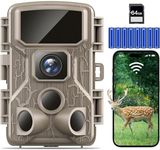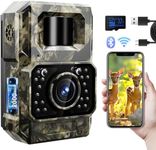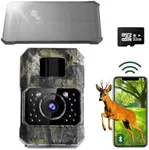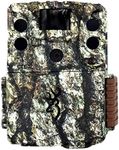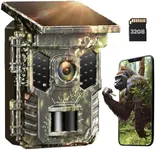Buying Guide for the Best Bluetooth Trail Camera
Choosing the right Bluetooth trail camera can significantly enhance your wildlife monitoring or security efforts. A trail camera is a device designed to capture images and videos of wildlife or intruders without being detected. The addition of Bluetooth functionality allows for easier access to the camera's data without needing to physically retrieve the memory card. To make an informed decision, you need to consider several key specifications that will determine the camera's performance and suitability for your needs.Image ResolutionImage resolution refers to the clarity and detail of the photos captured by the trail camera, measured in megapixels (MP). Higher resolution cameras produce clearer and more detailed images, which is important for identifying animals or intruders. Resolutions can range from 5MP to 20MP or more. If you need highly detailed images for research or security, opt for a higher resolution. For general wildlife observation, a mid-range resolution around 10-12MP should suffice.
Trigger SpeedTrigger speed is the time it takes for the camera to capture an image after detecting motion. This is crucial for capturing fast-moving animals or intruders. Trigger speeds can range from 0.1 seconds to over 1 second. A faster trigger speed (0.1-0.5 seconds) is ideal for capturing quick movements, ensuring you don't miss any action. If your primary use is monitoring slower-moving wildlife, a slightly slower trigger speed may be acceptable.
Detection RangeDetection range is the distance at which the camera can detect motion and trigger a photo or video. This range can vary from 50 feet to over 100 feet. A longer detection range is beneficial for covering larger areas and capturing distant subjects. If you are monitoring a small, confined area, a shorter detection range may be sufficient. Consider your specific monitoring area to determine the appropriate detection range.
Battery LifeBattery life indicates how long the camera can operate before needing a battery replacement or recharge. This is important for minimizing maintenance and ensuring continuous operation. Battery life can vary based on usage, with some cameras lasting several months on a single set of batteries. If you plan to leave the camera in a remote location for extended periods, look for models with longer battery life or consider using external power sources.
Night VisionNight vision capability allows the camera to capture images and videos in low light or complete darkness using infrared LEDs. This is essential for monitoring nocturnal wildlife or security purposes. Night vision quality can vary, with some cameras offering clear black-and-white images, while others provide color night vision. If nighttime monitoring is crucial, choose a camera with strong night vision capabilities and a good range of infrared illumination.
Storage OptionsStorage options refer to how the camera saves the captured images and videos. Most trail cameras use SD cards, with capacities ranging from 16GB to 128GB or more. Some cameras also offer cloud storage or internal memory. Consider how frequently you can access the camera to retrieve data. If you can't check the camera often, opt for a larger storage capacity to avoid running out of space. Additionally, ensure the camera supports the type of storage you prefer.
Bluetooth ConnectivityBluetooth connectivity allows you to wirelessly transfer images and videos from the camera to your smartphone or other devices. This is convenient for quickly checking the camera's captures without disturbing the setup. The range and speed of Bluetooth connectivity can vary. Ensure the camera's Bluetooth range is sufficient for your needs, and check if the camera's app or software is user-friendly and compatible with your devices.
Durability and Weather ResistanceDurability and weather resistance are critical for ensuring the camera can withstand outdoor conditions. Look for cameras with robust construction and an IP (Ingress Protection) rating that indicates resistance to dust and water. A higher IP rating (e.g., IP66 or IP67) means better protection against harsh weather. If you plan to use the camera in extreme environments, prioritize models with high durability and weather resistance to ensure longevity and reliable performance.
